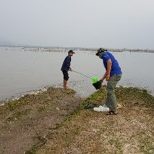Best Management Practices for mitigating agricultural nutrient pollution in the Mun River Basin, Thailand
Highlight: Rice paddies and staple crop fields are predominant in Mun River Basin. The cropping increase nutrient loading and soil loss to the river. Proper soil conservation practices can improve surface water quality. In this study, interconnections between soil and water quality were analyzed and the results suggest best management practice for the agricultural lands.
Researcher Name: Asst. Prof. Dr. Arika Bridhikitti
Years of execution: 2019-2021
Funder Name: National Research Council of Thailand co-funded by the National Natural Science Foundation of China
Objectives:
- To understand the spatial patterns of the associations between the land-soil properties and the hydro-water quality characteristics
- To propose suitable soil-water conservation measures for improving the water quality
Abstract: The Mun River in NE Thailand is one of the significant tributaries of the Lower Mekong River. Its poor river quality has been reported and agricultural activities were claimed to be major causes. This study aims to assess best management measures appropriately responsive to nutrient pollution in the Mun River Basin’s agricultural ecosystems. The data used for the analysis was acquired from field measurement during the 2018 wet season via satellite retrieval and secondary data collection. Linkages between land-soil datasets and hydro-water quality datasets were assessed through canonical correlation analysis. The results suggest possible conservation measures with crop yield improvement and fertilizer cost reduction in the western basin. For the southern basin which exhibits high sediment loading, integrated conservation measures for soil loss reduction with in-stream flow deceleration should be chosen. In the eastern basin, woody buffer strips and check dams should be prioritized. Both nutrient and sediment pollution were experienced in the middle part of the Mun River Basin and applications of low-P manure with mineral NK were recommended. Nonetheless, other soil-water conservation measures can be optionally applied to enhance effectiveness in watershed management.
| Region* | Conservation measures | ||
| Vegetative measures | App. of fertilizers | Mechanical measures | |
| West | Intercropping, Relay cropping, Strip cropping | Low-P manure with mineral N and K | Optional |
| Filter/buffer strip | |||
| South | Mulching, Filter/buffer strip, Strip cropping | Optional | Contour cultivation, Minimum tillage, No tillage or Sub soiling, Check dams |
| Middle | Optional | Low-P manure with mineral N and K | Optional |
| Lower | Buffer strip (woody forest is preferable) | Optional | Check dams |
Reference: Bridhikitti, A., Prabamroong, T., Gaohuan, L., & Guo-An, Y. (2021). Best management practices for mitigating agricultural nutrient pollution in the Mun River Basin, Thailand. Soil and Water Research, 16(2), 121-128.







